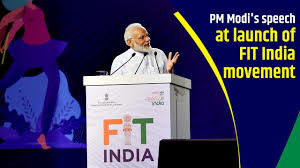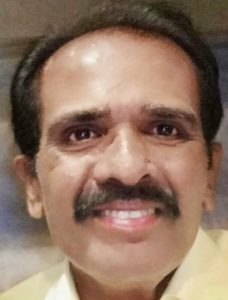Why we need “Fit India movement”? Is it a dream for a healthy nation? Better health is central to human happiness and well-being. Good health, more productivity and economic growth are the pillars of Nation Building. A healthy individual, healthy family and a healthy society are the essentials to make New India a Fit India. “Fit India Movement” aims to go beyond fitness.
“To insure good health: eat lightly, breathe deeply, live moderately, cultivate cheerfulness, and maintain an interest in life.” – William Londen (fl. 1658).
The birth anniversary of Major Dhyan chand, the greatest hockey player India has ever produced is observed as “National Sports Day” on 29th August every year. Our Honorable Prime Minister Shri. Narendra Modi chose the National Sports Day to launch the Fit India Movement for the benefit of its citizens and the Nation as a whole.
“Fit India Campaign” is being coordinated by the sports ministry and involves ministries of information & broadcasting, human resources department, panchayati raj and rural development, health and youth affairs. There is an active participation of agencies that promote health awareness, Multinational Corporations (MNCs) and prominent, popular film personalities. Health apps for physical fitness and mental health developed are available on Mobile digital platform (MDP).
Once considered a problem in high-income countries, overweight and obesity are now on the rise in low and middle-income countries, particularly in urban settings. Relationship between over-weight and obesity and diseases have been established: 44% diabetes, 23% of ischemic heart disease and 7%–41% of certain cancers are associated with obesity. Approximately, 35 million overweight children are living in developing nations and 8 million in developed countries.


The Honorable Prime Minister urged everyone to take up fitness as part of their daily lifestyle to get rid of ailments. The importance of staying healthy and fit has been emphasized in our society for generations. With changes in our pattern of living, improvement in socio-economic status and urbanization, changes in lifestyle, food habits and physical inactivity has led to a vicious cycle of complications. This leads to an associated increase in expenditure on healthcare and infrastructure development. “Fitness is zero percent investment with infinite returns,” Honorable Prime Minister Modi pointed out.
Physical inactivity leads to obesity that leads to diabetes, thyroid problems and cardiovascular diseases. W.H.O response: “WHO Global Strategy on Diet, Physical Activity and Health“, is introduction of policies and actions aimed at promoting healthy diets and increasing physical activity in entire population. W.H.O has also developed the “Global Action Plan for the Prevention and Control of non-communicable Diseases 2013-2020”. This aims to achieve the commitments of UN Political Declaration on non-communicable diseases.
The Internationa Diabetes Federation, IDF is urging families to learn more about the warning signs of diabetes, to be able to spot this serious life-long disease in their children. Diabetes was responsible for 4 million deaths in 2017. Untreated or uncontrolled diabetes can lead to life-changing complications like blindness, heart attack, amputation, kidney failure, and stroke. There are about 425 million people with diabetes in the world and 82 million people in the Southeast Region (SEA). By the year 2045 this will rise to 151 million. India is one of the 6 countries of IDF SEA region with over 72,946,400 cases of diabetes in India in 2017 with prevalence rate of 8.8% in adults.
Physical activity is defined by W.H.O as any bodily movement produced by skeletal muscles that require expenditure of energy. Working, playing, carrying out household chores, travelling, and engaging in recreational pursuits are also considered as physical activity.
W.H.O Key facts regarding physical activity (23 February 2018):
- Insufficient physical activity is one of the leading risk factors for death worldwide.
- Insufficient physical activity is a key risk factor for non-communicable diseases (NCDs) such as cardiovascular diseases, cancer and diabetes.
- Physical activity has significant health benefits and contributes to prevent NCDs.
- Globally, 1 in 4 adults is not active enough.
- More than 80% of the world’s adolescent population is insufficiently physically active.
- Policies to address insufficient physical activity are operational in 56% of WHO Member States.
- W.H.O Member States have agreed to reduce insufficient physical activity by 10% by 2025.
With the medical expenses minimized and the family is happy and prospering. Society also has overall positive health. Economic burden of physical inactivity and obesity include raised direct healthcare costs and productivity loss. By improving physical activities, Disability-adjusted life-years (DALYs) are avoided and there is an uptrend in economic growth. There is improvement in executive function and memory is also improved that ultimately develop a healthy nation. Physical activity and physical fitness improve academic performance in mathematics and reading capabilities.


Dr.N.Mariappan,Chennai
Consultant Plastic surgeon,
Mob:9901043568.











